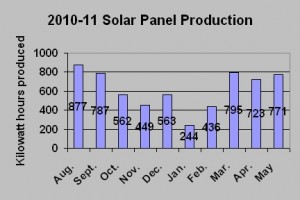House: Built in 2004; 2,992 square feet
System Description: 30-panel photovoltaic array producing electricity (not hot water) of about 8,500 kWh per year. It is a grid-connected system, meaning that the unused electricity is fed into the electrical grid, making the electric meter run backwards. When the panels aren’t producing, the meter starts running forward again.

Components: 30 panels, inverter (converts DC current to AC current), electric panel, utility meters
System provides: about 90% of the yearly household electric use
Installation: July, 2010 by Sunlight Solar www.sunlightsolar.com
Town permits involved: Yes. Sunlight Solar handled all the necessary permits.
Price: $29,779, i.e., $50,399 minus $5,500 Commonwealth Solar Program rebate, minus $15,120 federal tax credit, representing 30% of the purchase price.
Decrease in electric bill, plus SREC money (payments through at least 2016 for the clean energy the panels produce) equal the payments for the 15-year loan taken out to pay for the system.
Payback Period – Basically the system pays for itself. There was no large up-front payment, since the entire amount was borrowed and is being repaid monthly. Owners were in the red until receiving the Federal income tax refund in April 2011. After getting the Federal tax refund, they should remain well in the black for the remaining life of the system.
Note: SREC’s (Solar Renewable Energy Certificates) are auctioned off to utilities, which are required to buy a certain amount of clean energy. This auction money funds payments to people who produce solar power. Depending on the auction price and how much electricity is produced, the owners should get quarterly payments of $600-$1000 through 2016.
Advantages:
- Electric bills are minimal
- Great feeling knowing that we are producing our own energy
- Lowers our carbon footprint
- Saves money
Disadvantages:
- System parts may occasionally need repair. The 25-year warranty and the fact that the system has no moving parts make this unlikely anytime soon.
Questions:
What happens when the panels get covered with snow?
Snow-covered parts of the panels don’t produce electricity. The black solar panels melt away minor snow falls fairly quickly. However, the 15-inch snowfall on Jan. 11, and later snow, blocked most of the panels until Feb. 15.
Do your panels keep producing during a power outage?
No. We have a grid-tied system, which shuts down automatically during an outage in order to protect workers handling downed power lines. The only way to have power during an outage is to have a battery backup system, which adds considerable cost to installation.

